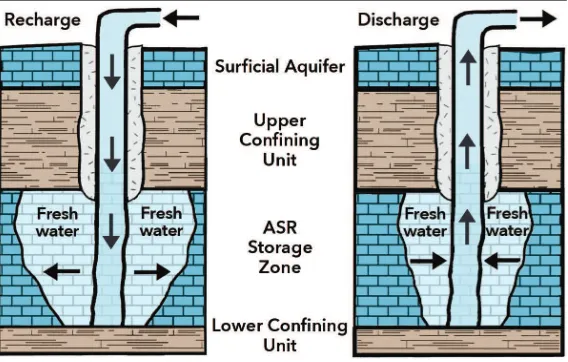WATER SCIENCE AND TECHNOLOGY BOARD APRIL 2015
Review of the Everglades Aquifer Storage and Recovery
Regional Study
THIS REPORT REVIEWS AN 11-YEAR REGIONAL STUDY carried out by the U.S. Army Corps of Engineers and the South Florida Water Management District to assess the regional effects of large-scale aquifer storage and recovery (ASR) in the Florida Everglades. The regional study represents a signiicant advancement in the understanding of large-scale implementation in South Florida; however, there are still many uncertain-ties that merit additional study before large-scale ASR is implemented. Phased implementation of ASR could provide incremental near-term storage beneits while also addressing the critical uncertainties that remain.
The Florida Everglades, a unique aquatic ecosystem that is home to 67 threatened and endangered species, has been greatly altered over the past century by water management to support agricultural and urban development. The Comprehensive Everglades Restoration Plan, launched in 2000, is a joint effort led by the state and federal government to reverse the decline of the ecosystem.
Increasing water storage is a critical component of the Everglades restora-tion, because extensive canal drainage and development over the past century greatly reduced natural water storage in the system. In addition to surface reservoirs, the resto-ration plan included 333 ASR wells that would store up to 1.7 billion gallons of water per day, for recovery and use during dry periods.
Aquifer storage and recovery has been used successfully in Florida since 1983, but not at the large scales proposed in the Everglades restoration program. To address uncertainties regarding the regional effects of large-scale ASR in the Everglades, the U.S. Army Corps of Engineers (USACE) and the South Florida Water Management District conducted an 11-year Regional Study that focused on the hydro-geology of the Florida aquifer system, water quality changes during aquifer storage, possible ecological risks posed by recovered water, and the regional capacity for implementing ASR.
At the request of the USACE, the National Research Council’s Water Science and Technology Board convened a committee of experts to review
the Regional Study Technical Data Report and assess progress towards reducing uncertainties related to full-scale ASR implementation. The committee was not asked to provide recommendations on the appro-priate role of ASR in the Everglades restoration.
WHAT THE REGIONAL STUDY FOUND The Regional Study included literature syntheses, laboratory testing, and ield scale experimentation primarily at two pilot ASR sites, and represents a signiicant advancement in the understanding of large-scale ASR implementation in South Florida. The study included the development of a regional groundwater model, which enabled simulations indicating that only about 131 wells can be operated without signiicant regional effects on well pressure and groundwater heads—far fewer than the number originally envi-sioned in the Everglades restoration.
Committee to Review the Florida Aquifer Storage and Recovery Regional Study Technical Data Report: James Saiers
(Chair), Yale University; Charles F. Harvey, Massachusetts Institute of Technology; William Hopkins, Virginia Polytechnic Institute and State University; Kenneth W. Potter, University of Wisconsin, Madison; René Marie Price, Florida International University; R. David G. Pyne, ASR Systems, LLC, Gainesville, FL; Larry Robinson, Florida A&M University; Elizabeth J. Screaton, University of Florida, Gainesville; R. Rhodes Trussell, Trussell Technologies, Inc., Pasadena, CA; Stephanie E. Johnson (Study Director), Brendan McGovern (Senior Program Assistant), National Research Council.
he National Academies appointed the above committee of experts to address the speciic task requested by the U.S. Army Corps of Engineers Jacksonville District. he members volunteered their time for this activity; their report is peer-reviewed and the inal product signed of by both the committee members and the National Academies. his report brief was prepared by the National Research Council based on the committee’s report.
For more information, contact the Water Science and Technology Board at (202) 334-3422 or visit http://dels.nas.edu/wstb. Copies of Review of the Everglades Aquifer Storage and Recovery Regional Study are available from the National Academies Press, 500 Fith Street, NW, Washington, D.C. 20001; (800) 624-6242; www.nap.edu.
Permission granted to reproduce this document in its entirety with no additions or alterations. Permission for images/igures must be obtained from their original source.
© 2015 he National Academy of Sciences
Locate additional information, including related reports, at http://dels.nas.edu/wstb Read, purchase, or download a free PDF of this report at http://www.nap.edu ADDRESSING UNCERTAINTIES
The committee agrees with the Regional Study’s inding that there are no “fatal laws” in the use of ASR for restoration, but there are still many uncertainties that merit additional study. The committee identiied ive research areas as the highest priorities to inform restoration decision making:
